Colony 1:
Camponotus Pennsylvanicus
Update 7-7-2016
My pavement ant colony found their way into this colonies nest and they killed about 15 worker, only the queen managed to live. I now have her in a test tube and small outworld setup in hopes she lays again.

In the picture below they started to close off the entrance. They are chewing the cork that was used to connect the tubing to the haven. Sign they're entering/in diapause I believe.

They aren't forging much if at all. They took to a drop of honey, but other than that haven't had much resources other than water during their diapause.
As for the brood; I haven't seen any development other than the immature larvae they're overwintering.
Colony 2:
Camponotus sp.
Currently updating/pictures
Colony 3:
Camponotus Pennsylvanicus
Approximately 200 workers.
Currently updating/pictures
Thanks, I will post updates when any news comes up.
Edited by iXvXi, July 7 2016 - 2:21 PM.






















